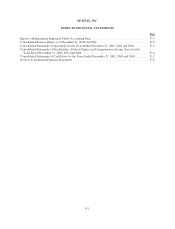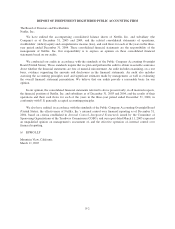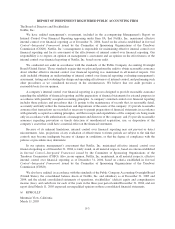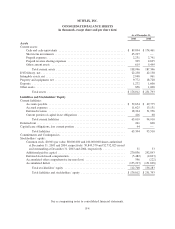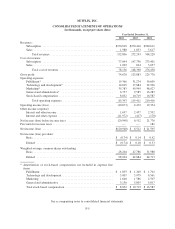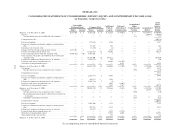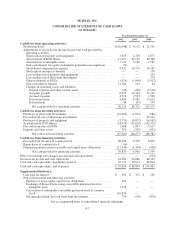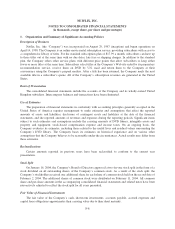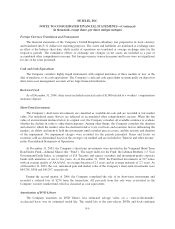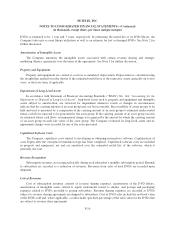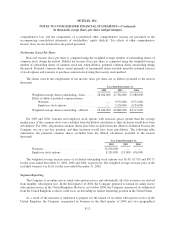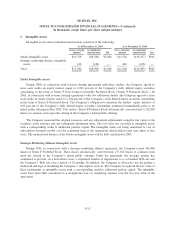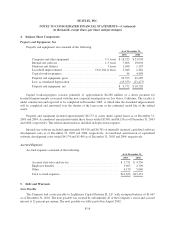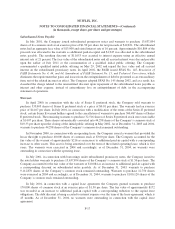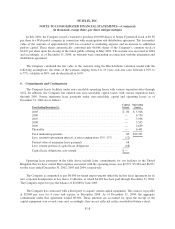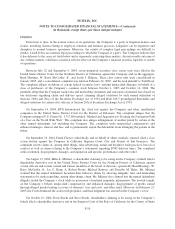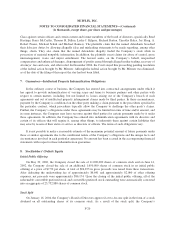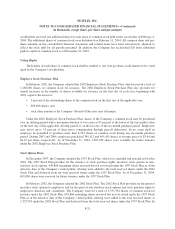NetFlix 2004 Annual Report Download - page 71
Download and view the complete annual report
Please find page 71 of the 2004 NetFlix annual report below. You can navigate through the pages in the report by either clicking on the pages listed below, or by using the keyword search tool below to find specific information within the annual report.NETFLIX, INC.
NOTES TO CONSOLIDATED FINANCIAL STATEMENTS—(Continued)
(in thousands, except share, per share and percentages)
Fulfillment
Fulfillment expenses represent those costs incurred in operating and staffing the Company’s fulfillment and
customer service centers, including costs attributable to receiving, inspecting and warehousing the Company’s
DVD library. Fulfillment expenses also include credit card fees.
Technology and Development
Technology and development expenses consist of payroll and related costs incurred in testing, maintaining
and modifying the Company’s Web Site, its recommendation service, developing solutions for downloading
movies to subscribers, telecommunications systems and infrastructure and other internal-use software systems.
Technology and development expenses also include depreciation on the computer hardware and capitalized
software.
Marketing
Marketing expenses consist of payroll and related expenses and advertising expenses. Advertising expenses
include marketing program expenditures and other promotional activities, including revenue sharing expenses,
postage and packaging expenses and library amortization related to free trial periods. Advertising costs are
expensed as incurred except for advertising production costs, which are expensed the first time the advertising is
run. Advertising expense totaled approximately $32,405, $46,459, and $91,799 in 2002, 2003 and 2004,
respectively.
In November of 2002, the Emerging Issues Task Force (“ EITF”) reached a consensus on Issue No. 02-16,
Accounting by a Customer (Including a Reseller) for Certain Consideration Received from a Vendor, which
addresses the accounting for cash consideration given to a reseller of a vendor’s products from the vendor. The
Company and its vendors participate in a variety of cooperative advertising programs and other promotional
programs in which the vendors provide the Company with cash consideration in exchange for marketing and
advertising of the vendor’s products. If the consideration received represents reimbursement of specific
incremental and identifiable costs incurred to promote the vendor’s product, it is recorded as an offset to the
associated marketing expense incurred. Any reimbursement greater than the costs incurred is recognized as a
reduction of cost of revenues when recognized in the Company’s statement of operations.
Income Taxes
The Company accounts for income taxes using the asset and liability method. Deferred income taxes are
recognized by applying enacted statutory tax rates applicable to future years to differences between the financial
statement carrying amounts of existing assets and liabilities and their respective tax bases and operating loss and
tax credit carryforwards. The effect on deferred tax assets and liabilities of a change in tax rates is recognized in
income in the period that includes the enactment date. The measurement of deferred tax assets is reduced, if
necessary, by a valuation allowance for any tax benefits for which future realization is uncertain.
Comprehensive Income (Loss)
The Company reports comprehensive income or loss in accordance with the provisions of SFAS No. 130,
“Reporting Comprehensive Income”, which establishes standards for reporting comprehensive income and its
components in the financial statements. The components of other comprehensive income (loss) consist of
unrealized gains and losses on available-for-sale securities and cumulative translation adjustments. Total
F-11


